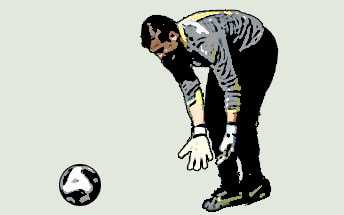Football Back Pass Rule
Soccer back pass rule makes the game more exciting. This simplified guide tells you why.

The back-pass rule prohibits the goalkeeper from handling the ball if it has been passed to him intentionally by a teammate. This football rule was introduced by FIFA in 1992 to discourage players from wasting time and playing overly defensive tactics.
Pass back rule explanation
Before football had the back pass rule, a team who goes up by a goal could intentionally waste time by keeping the ball in their own half and repeatedly passing it to the goalkeeper.
The goalie, in turn, would pick up the ball, hand-dribble it, before passing it back to the nearest defender or kicking it far into the opponent’s field. This strategy might be effective for the leading team, but it is a game not worth viewing by spectators.

In 1992, FIFA, soccer’s highest governing body, introduced a new rule to prevent players from playing a cynical and overly defensive game. Called the back pass rule, it prohibits the goalkeeper from handling the ball under the following circumstances:
- when the ball is intentionally kicked to him by a teammate
- when receiving it directly from a throw-in
- when he has already released the ball to the ground after a save
A goalkeeper who violates the back pass rule will be penalized with an indirect free kick from the point where he picks up the ball.
The referee must be sure that the pass to the goalkeeper is intentional before calling a violation of the back pass rule. Otherwise, he would let the play go on instead of making a bad call.
Trickery or unsportsmanlike behavior

Since FIFA’s back pass rule explicitly states that the goalie cannot pick up the ball “if has been deliberately kicked to him by a teammate,” some players attempt to circumvent the law by using other means to pass the ball back. This action is known as trickery.
Trickery includes flicking the ball up so one could pass it to the goalie with the knee, chest, or head. Such action will be penalized whether the goalie touches the ball or not since it is a blatant attempt by a player to circumvent the first condition of the back pass law.
An indirect free kick will be awarded to the opposing team on the spot where the ball is redirected towards the keeper. However, it must be obvious that the pass is meant to waste time.
If a head, chest, or knee pass to the keeper is done to eliminate danger (for example, a player heads the ball to the goalie after a pass from a teammate because there is an attacker beside him), the referee will not call a violation of the back pass rule.
Legal back-passes to the goalkeeper
The back pass rule does not totally outlaw passing back to the goalkeeper. Players may still do so, but the keeper can only use his feet to control the ball.
There is no violation of the back pass rule if the goalkeeper collects the ball after it is unintentionally redirected to him by a teammate. He may use his hands if the ball deflects on a teammate after a shot or if bounces off a teammate after a corner kick.
